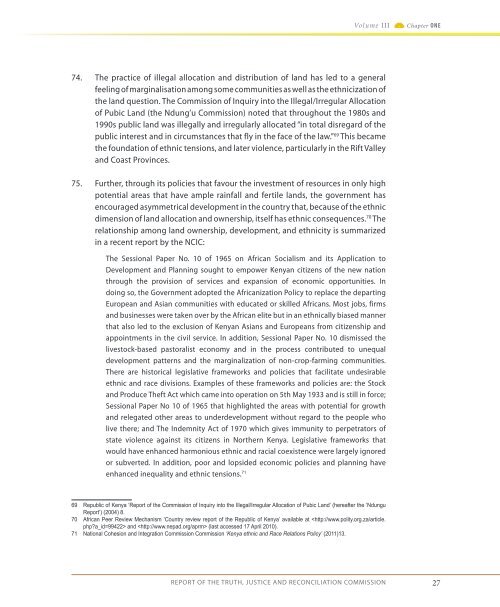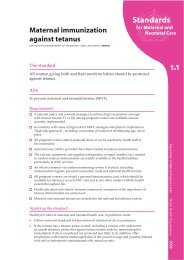1uvZ4zN
1uvZ4zN
1uvZ4zN
You also want an ePaper? Increase the reach of your titles
YUMPU automatically turns print PDFs into web optimized ePapers that Google loves.
Volume III<br />
Chapter ONE<br />
74. The practice of illegal allocation and distribution of land has led to a general<br />
feeling of marginalisation among some communities as well as the ethnicization of<br />
the land question. The Commission of Inquiry into the Illegal/Irregular Allocation<br />
of Pubic Land (the Ndung’u Commission) noted that throughout the 1980s and<br />
1990s public land was illegally and irregularly allocated “in total disregard of the<br />
public interest and in circumstances that fly in the face of the law.” 69 This became<br />
the foundation of ethnic tensions, and later violence, particularly in the Rift Valley<br />
and Coast Provinces.<br />
75. Further, through its policies that favour the investment of resources in only high<br />
potential areas that have ample rainfall and fertile lands, the government has<br />
encouraged asymmetrical development in the country that, because of the ethnic<br />
dimension of land allocation and ownership, itself has ethnic consequences. 70 The<br />
relationship among land ownership, development, and ethnicity is summarized<br />
in a recent report by the NCIC:<br />
The Sessional Paper No. 10 of 1965 on African Socialism and its Application to<br />
Development and Planning sought to empower Kenyan citizens of the new nation<br />
through the provision of services and expansion of economic opportunities. In<br />
doing so, the Government adopted the Africanization Policy to replace the departing<br />
European and Asian communities with educated or skilled Africans. Most jobs, firms<br />
and businesses were taken over by the African elite but in an ethnically biased manner<br />
that also led to the exclusion of Kenyan Asians and Europeans from citizenship and<br />
appointments in the civil service. In addition, Sessional Paper No. 10 dismissed the<br />
livestock-based pastoralist economy and in the process contributed to unequal<br />
development patterns and the marginalization of non-crop-farming communities.<br />
There are historical legislative frameworks and policies that facilitate undesirable<br />
ethnic and race divisions. Examples of these frameworks and policies are: the Stock<br />
and Produce Theft Act which came into operation on 5th May 1933 and is still in force;<br />
Sessional Paper No 10 of 1965 that highlighted the areas with potential for growth<br />
and relegated other areas to underdevelopment without regard to the people who<br />
live there; and The Indemnity Act of 1970 which gives immunity to perpetrators of<br />
state violence against its citizens in Northern Kenya. Legislative frameworks that<br />
would have enhanced harmonious ethnic and racial coexistence were largely ignored<br />
or subverted. In addition, poor and lopsided economic policies and planning have<br />
enhanced inequality and ethnic tensions. 71<br />
69 Republic of Kenya ‘Report of the Commission of Inquiry into the Illegal/Irregular Allocation of Pubic Land’ (hereafter the ‘Ndungu<br />
Report’) (2004) 8.<br />
70 African Peer Review Mechanism ‘Country review report of the Republic of Kenya’ available at and (last accessed 17 April 2010).<br />
71 National Cohesion and Integration Commission Commission ‘Kenya ethnic and Race Relations Policy’ (2011)13.<br />
REPORT OF THE TRUTH, JUSTICE AND RECONCILIATION COMMISSION<br />
27






